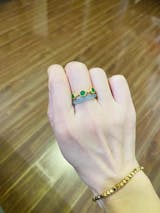The Unique Charm and Significance of Wrathful Deities
Introduction
In the art of the plateau, whether in Thangka paintings or sculptures, the presence of wrathful deities radiates a distinctive charm. These images not only make Tibetan Buddhist art stand out in the world of religious art but also greatly enrich the artistic treasures of the Chinese nation. The wrathful deities, with their fierce and majestic forms, captivate the viewer while embodying profound religious and cultural significance.

The Compassionate Essence of Wrathful Deities
It is often said that the Buddha possesses thirty-two physical marks and eighty minor characteristics, all extraordinary and flawless. From the radiant Buddha, to the serene gaze of bodhisattvas, to the glaring Vajra, each manifestation reflects compassion. Despite their terrifying and fierce appearances, the essence of wrathful deities remains external wrath and internal compassion. This is fundamentally different from mundane anger. Mundane anger stems from greed, hatred, and ignorance, whereas Buddhas and bodhisattvas are free from these emotions. Their wrath is a means to subdue obstacles and protect beings.
The wrathful manifestations aim to help practitioners overcome internal and external hindrances. By imitating and surpassing the terrifying appearances of demons, Buddhas and bodhisattvas display overwhelming power, instilling confidence in practitioners to conquer both inner afflictions and external adversities. For instance, Shakyamuni Buddha’s wrathful form is Acala (Achala), Avalokiteshvara’s is Hayagriva, and Ksitigarbha’s is Yamantaka. Each wrathful form embodies the wisdom and compassion of the enlightened beings.

Artistic Characteristics of Wrathful Deities
In artistic representations, wrathful deities are often depicted with glaring eyes and raised arms, exuding a powerful and awe-inspiring presence. The postures of their feet vary dynamically, conveying dramatic tension. To emphasize their power and grandeur, artists often employ exaggerated elements. Intense color contrasts, fiery backgrounds, and dynamic poses resembling warriors or dancers amplify the impact of these images.
In Thangka paintings, the wrathful deities are not merely depictions of angry Buddhas. The bloodshed in the imagery symbolizes attachment, ego, and arrogance in the human mind. The terrifying scenes are metaphors for the dharma’s ability to shatter all demonic obstacles.
Wrathful Deities and Tibetan Buddhist Culture
The existence of wrathful deities is closely tied to the history, culture, and societal context of Tibetan Buddhism. According to legend, when Guru Padmasambhava, known as the "Second Buddha" in the plateau, first arrived in Tibet, he encountered numerous demons and spirits obstructing him. Using his spiritual powers, Guru Rinpoche subdued them, making them vow to protect the dharma. This story later became a famous theme in Thangka art—the wrathful Guru Rinpoche.
Wrathful deities are often portrayed as protectors and tutelary deities, symbolizing power and majesty. Such depictions hold a unique didactic significance in religious culture, reminding people of the power of faith and the importance of spiritual practice.

Symbolism of Wrathful Deities
Wrathful deities hold not only artistic and religious significance but also symbolize the transformation and purification of the practitioner’s mind. Their ferocious appearances are designed to terrify external demons and, more importantly, represent the tangible forms of internal darkness. By meditating on wrathful deities, practitioners can overcome inner fears, attachments, and delusions, paving the way to enlightenment and purity.
As a well-known saying goes, “The glaring Vajra subdues the Four Maras, while the serene bodhisattva embodies compassion for all six realms.” The compassion of wrathful deities is like a rose, beautiful yet thorny, reminding practitioners that the pursuit of truth requires both kindness and strength.

Conclusion
The wrathful deities in Tibetan Buddhist art, with their unique artistic expressions and profound religious connotations, add a vivid touch to the cultural treasury of the Chinese nation. These images not only captivate the eye but also inspire reflection on inner attachments and fears. Between wrath and compassion, one can feel the great wisdom and boundless compassion of the Buddhas and bodhisattvas.
Related articles:
Padmasambhava: The Founder of Tibetan Buddhism
Five Wealth Gods in Tibetan Buddhism: Welcoming Prosperity in the New Year
Thangka Pendants: Taboos, Care, and Preservation



























































